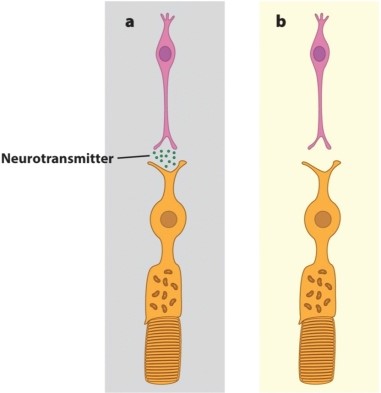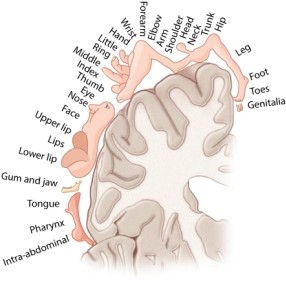A) supporting cells
B) taste sensory neurons
C) sensory microvilli
D) interneurons
Correct Answer

verified
Correct Answer
verified
Multiple Choice
In the figure below, panel a shows a photoreceptor and its postsynaptic cell in the dark, and panel b shows both cells in the light. What causes the change observed in this figure? 
A) Hyperpolarization of the rod cell in the dark causes release of a neurotransmitter.
B) Hyperpolarization of the rod cell in the light inhibits release of a neurotransmitter.
C) Depolarization of the rod cell in the light inhibits release of neurotransmitter.
D) This figure is incorrect; dark and light are reversed.
Correct Answer

verified
Correct Answer
verified
Multiple Choice
How are sound vibrations amplified in a vertebrate ear?
A) by movements of the basilar membrane induced by fluid vibrations
B) by movement of the bones of the middle ear
C) by differences in the surface area of the eardrum versus the oval window
D) by movement of the bones of the middle ear and by differences in the surface area of the eardrum versus the oval window
Correct Answer

verified
Correct Answer
verified
Multiple Choice
What part of a taste sensory neuron is directly involved with receiving stimuli?
A) microvilli
B) supporting cells
C) axons
D) papillae
Correct Answer

verified
Correct Answer
verified
Multiple Choice
Light-sensing organs were thought to evolve FIRST in:
A) cnidarians.
B) vertebrates.
C) bacteria.
D) roundworms.
Correct Answer

verified
Correct Answer
verified
Multiple Choice
Why do flatworms move away from light sources?
A) to avoid skin cancer
B) to avoid the mutagenic effects of direct sunlight
C) to hide from predators
D) Their prey are always found in dark environments.
Correct Answer

verified
Correct Answer
verified
Multiple Choice
Which region is LARGEST in a mammalian brain?
A) cerebral cortex
B) brainstem
C) cerebellum
D) hippocampus
Correct Answer

verified
Correct Answer
verified
Multiple Choice
What do spatial and temporal summation have in common?
A) Both lead to lateral inhibition.
B) Both lead to adaptation to continuous stimuli.
C) Both increase the firing rate of neighboring neurons.
Correct Answer

verified
Correct Answer
verified
Multiple Choice
The flexibility of the basilar membrane varies along its length. Activation of different regions of the basilar membrane enables perception of sounds of different:
A) pitch.
B) amplitude.
C) intensity.
D) loudness.
Correct Answer

verified
Correct Answer
verified
Multiple Choice
The frequency of sound waves reaching the ear determines:
A) intensity of sound.
B) loudness.
C) pitch.
D) tone.
Correct Answer

verified
Correct Answer
verified
Multiple Choice
Many television chefs will season their food, somewhat liberally, with salt and pepper. On occasion you will even hear the remark, "Salt wakes up the flavor of the food." Why would the addition of salt help to heighten the "taste" of the food?
A) The salt changes the ion concentration in the mouth, activating salt-sensitive taste bud receptors and increasing the number of cells that depolarize and transduce other flavor signals to the brain.
B) It does not heighten the taste of the food; everything just tastes salty.
C) The salt can combine with the taste molecules so they bind more strongly to their receptors.
D) The salt causes more saliva to be produced, and that results in more taste molecules reaching the taste cells in the mouth.
Correct Answer

verified
Correct Answer
verified
Multiple Choice
The malleus, incus, and stapes are all part of the:
A) inner ear.
B) middle ear.
C) outer ear.
D) cochlea.
Correct Answer

verified
Correct Answer
verified
Multiple Choice
When you actually perceive the "taste" of something you are eating, it means that:
A) a single sensory cell has been depolarized and the signal has been transmitted to the area of the brain that perceives the taste.
B) a single taste bud has been depolarized and the signal has been transmitted to the area of the brain that perceives the taste.
C) multiple sensory cells have been depolarized by a sufficient amount of a food item and their combined EPSPs have been summed to transmit a signal to the brain.
D) multiple sensory cells have been depolarized by a variety of food items.
Correct Answer

verified
Correct Answer
verified
Multiple Choice
A thermoreceptor responds to:
A) wet and/or dry environmental conditions.
B) temperature.
C) physical force.
D) pain.
Correct Answer

verified
Correct Answer
verified
Multiple Choice
Color vision in vertebrates is made possible by _____ cells.
A) cone
B) rod
C) amicrine
D) ganglion
Correct Answer

verified
Correct Answer
verified
Multiple Choice
There are several references in the text to topographic mapping of sensory information in the brain. What is topographic mapping?
A) It is a spatial arrangement of neurons in the brain that preserves the spatial relationships of information received by a sensory system.
B) It is a three-dimensional map that represents the receptive field of a given sensory receptor.
C) It explains why each hemisphere of the brain interacts primarily with one-half of the body.
D) It refers to the division of the brain into the forebrain, midbrain, and hindbrain.
Correct Answer

verified
Correct Answer
verified
Multiple Choice
This map of the somatosensory cortex shows distorted body parts because: 
A) that is the only way an illustrator can fit all the parts into the picture.
B) it reflects the relative amount of sensory cortex devoted to pressure and touch sensations from a body part.
C) it reflects the number of muscle fibers that are devoted to stimulating a particular body part.
D) it reflects differences in different people depending on how that person perceives his or her body parts.
Correct Answer

verified
Correct Answer
verified
Multiple Choice
Which of the following does NOT contribute to what is described as cognition?
A) problem solving
B) regular breathing
C) recollection of the past
D) integration of information
Correct Answer

verified
Correct Answer
verified
Multiple Choice
With the proper stimuli, chemoreceptors and mechanoreceptors are depolarized. This is a result of:
A) potassium channels opening.
B) sodium channels opening.
C) chloride channels opening.
D) sodium channels closing.
E) potassium channels closing.
Correct Answer

verified
Correct Answer
verified
Multiple Choice
How many different types of chemoreceptors can be found in the taste buds?
A) hundreds
B) thousands
C) 40 to 50
D) five
Correct Answer

verified
Correct Answer
verified
Showing 141 - 160 of 205
Related Exams